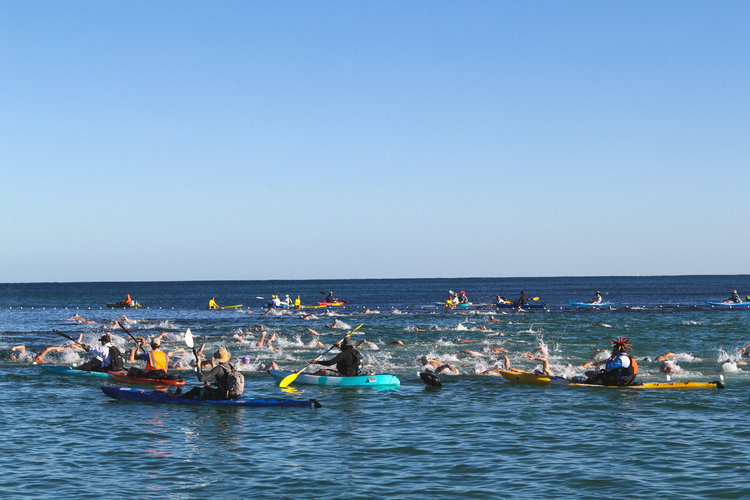Alexandra Geneve

The Rottnest Swim is a 19.7km open-water swim from Cottesloe Beach to Rottnest Island. Playfully nicknamed the ‘Rotto Swim,’ it is one of Western Australia’s most iconic events and one of the biggest open-water swimming events in the world.
Alexandra is not a swimmer, nor is she involved directly in the Rotto Swim. Her passion for shipwrecks drove her to write this creative-non-fiction piece that imagines the story behind the Rottnest swimming legend, Herbert Voigt. Referred to as ‘Mr Shark Bait’ by the press, Herbert Voigt was a man well-known by locals for his affinity with the ocean. Often spending hours out on the water, his story is one of many unofficial Rotto Swims worth telling.
Against the Current
In 1969, two weeks after my brother died, which altered the future for us, Herbert Voigt’s skull and femur bone were found bobbing near the wreck of the Alkimos.
Herbert had been twenty-three and what you might call ‘strapping.’ He had a prominent, squared jaw and large barrel chest; his build was not unlike George Reeves’s 1950s Superman with his protruding chest and drawn in stomach. People would nod knowingly if one were to describe him as a Kraut, which he was.
He loved the ocean with a passion that seemed disturbing to some, even for those from the Perth beachside suburbs who considered the Indian Ocean an extension of themselves. Herbert would park his battered old Valiant with South Australian plates on the road by the beach and swim far out to sea off Cottesloe or Scarborough, sometimes Coogee, and bob out there for hours any day of the week when he could find the time between jobs.
He was known to pull behind him, with a rubber strap tied around his ankle, a baby’s bath that contained a bottle of beer and a sandwich of white bread, butter, and ham wrapped in rainbow-waxed paper. A two-hour lunch break would not be out of the question, although it was often more than a half a mile out to sea.
I wonder what it had been like out there, just bobbing on the waves, drinking what was sure to have been a warm beer by then. I imagine the butter having melted between the ham and the slices of bread, perhaps a crust now and then when money was short. I imagine the solitude of that stretch of water and the sky touching and reflecting endlessly. I imagine the slapping of water and the far-off sound of birds wheeling in the air above; his breathing, somewhat laboured, but without the accompanying shortness of anxiety. And I can’t help but imagine the depth below his moving feet, the dark of the shadows that wince and flinch at an intruder’s presence.
I see the glint of sun off the bottle from which Herbert takes large, German swigs; and that same glint of sunlight reaching only just so far down beneath the diamond waves so as to illuminate his cycling legs, the rounded edge of his toes, before flickering off, submerging in the deep green to the inky blackness of the trench. We now know that where Herbert Voigt took his last breath, there lies close a deep abyss the length of the Grand Canyon and twice as deep. In 1969 no one knew it was out there. Or, if they did, it was impossible to prove. They certainly didn’t know it was over 4000 metres deep. Australians didn’t think in terms of metres in those days. Herbert seemed to have had little fear of the deep; if he did, he certainly didn’t show it to the world. Or perhaps a fear of the deep is not what he needed to be afraid of. Perhaps if he’d known that the trench fell to 2.5 miles, and he was bobbing only 12.4 miles from where that chasm fell away, he might have had a momentary pause for concern. But he didn’t. And so he didn’t.
That day in 1969, Herbert Voigt had already been nick-named ‘Mr Shark Bait’ by the locals and daily newspapers. That day, he decided to pass up the offer of a support boat and crew, and strapped that knife to his outer right leg between the ankle and calf. That day, the off-shore weather report said calm inshore, choppy white-capped off-shore. That day, the media found out and they photographed and interviewed Mr Shark Bait on Cottesloe Beach and tried to dissuade him, in his black and white form-fitting gingham-checked bathers, from making the swim, to perhaps re-think his Rottnest quest; but that day, once again, he refused to listen and strode out to sea at 7.15am to make good on a bet, swim the 12 miles to Rottnest Island, and get there in time for lunch.
He was swept off course.
This story was originally published on March 26, 2018.